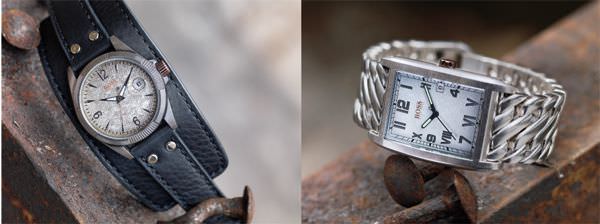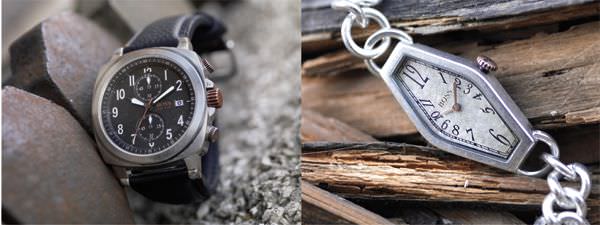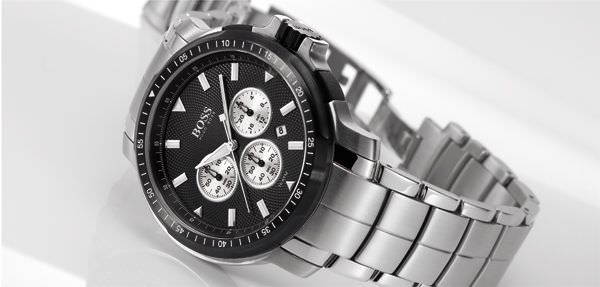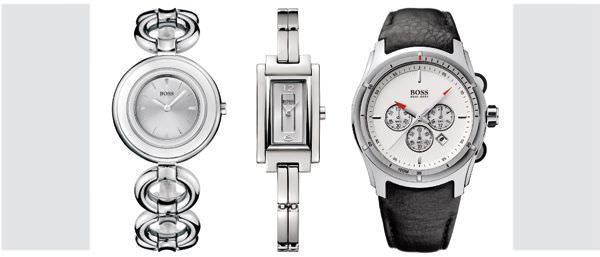The Hugo Boss license was taken over by the MGI Luxury Group (otherwise known as Movado) in December, 2004. Before that, the license had been held, since 1996, by ‘Tempus Concept’. After a year of transition, the group re-launched the Hugo Boss watch brand at BaselWorld 2006, this time, centring it on the specific universe of the Hugo Boss fashion brand.
Actually, Hugo Boss is not one brand, but rather several collections that are designed to be different ‘brands’. Boss Black is the most classic and purest; Orange is the most ‘vintage’; Hugo is the closest to haute couture; and finally, Boss Green is the sports line, principally oriented towards golf.

HB-140, HB-142

HB-141, HB-148
Interlocking brands
With these interlocking collections, Hugo Boss watches began first with Boss Black, followed this year by Boss Orange, with Hugo planned for 2009. (Boss Green will perhaps come later.) The distribution network has been entirely re-worked, with headquarters in La Chaux-de-Fonds and subsidiaries in Canada, the USA, and Hong Kong. It also has offices in Japan, Miami (which handles all of South America), and Singapore (which handles all of Southeast Asia), as well as distributors in Europe, which are handled directly from Switzerland.
When Movado purchased the license from Tempus Concept, there were about 100,000 watches produced per year, distributed in forty countries via 3,000 points of sale. Today, the Hugo Boss production is approximately 300,000 watches distributed through 2,500 sales points in fifty-five countries.

HB-156
Lower average price
The increase in the number of watches produced has been made possible because of a decrease in the average price of Hugo Boss watches. This price cut is due to decisive stra-tegic policies as well as, undoubtedly, to certain synergies within the MGI Group.
The group has two quite distinct ‘legs’—the Swiss brands (Movado, Ebel, and Concord) and the licensed brands (in the order of their acquisition: Coach, Tommy Hillfiger, Hugo Boss, Juicy Couture (a very ‘girlie’ Californian brand) and recently Lacoste). With these latter brands, Boss shares the back office (financial matters) and the supply chain (management of supplies), which is handled from Hong Kong. Distribution, however, is totally independent.
Xavier Gauderlot, General Manager of the Hugo Boss license, is understandably proud of the brand’s success, which he primarily attri-butes to the brand’s positioning in the ‘higher fashion segment’. The prices range from 100¤ to 500, even reaching 600. The watches are openly produced in China, and the company has no pretensions of trying to capitalize on the ‘Swiss Made’ label.
“We cannot ask a client who buys a suit for 600 ¤ to purchase the same brand watch at a higher price,” insists Gauderlot. While he feels that the success of Hugo Boss is due mainly to its re-positioning in terms of price, it is also due to other factors—the strength of the brand name itself and its fashion universe; the strength of the Movado Group; good marketing; a dynamic distribution network; the variety of collections (some 200 models); the introduction of new models three times per year, fashion oblige; and the intelligence of the designs.
“On the design level, for example,” explains Gauderlot, “we are looking for both quality and beauty in the details. The client must feel that there is true added value in relation to the price of the product.”

HB-126, HB-153, HB-156
Quality products
Is this just pure marketing talk? Well, when touching and trying on the products, one re-alizes that buyers of Boss watches do, in fact, ‘get their money’s worth’. The elegance of the design, the attention to detail (crown, horns, clasps, dial, and hour markers), and the care in finishing all evoke a quality timepiece. The brand’s entry level collection, Boss Black, is composed of watches with rather pure and classic lines that are available in black, silver, and grey versions.
Although the lines are essentially masculine, (80 percent), there are also some slightly more fantasy and lifestyle pieces with original ladies’ models, but overall they remain relatively discreet and in very good taste.
Boss Orange presents, on the other hand, a much more unconventional and effective approach to design. Decidedly, vintage, it proposes a series of pieces, for ‘fashion victims’, with styling reminiscent of the 1930s and 1940s. They are available in silver plated steel, made to look ‘old’ with added touches of copper, and dials crafted to appear quite ‘used’ like a pair of old and torn jeans.
Source: Europa Star December-Januar 2008 Magazine Issue




